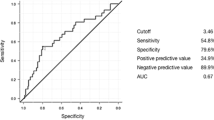Abstract
Introduction
The inflammatory response is known to have an important role in tumourigenesis and the response to treatment. Previous studies have demonstrated that inflammatory cell ratios such as the neutrophil-to-lymphocyte ratio (NLR) can predict survival and recurrence following surgery for various cancers. The objective of this study was to demonstrate if pre-operative NLR has a role in predicting post-operative septic complications in patients undergoing rectal cancer surgery.
Methodology
Consecutive patients undergoing scheduled resection for rectal cancer in a tertiary centre from July 2007 to Dec 2015 were included. Data was gathered from a prospectively held database of rectal cancer. Normally distributed data were compared with paired t tests (mean ± standard error in the mean (SEM)), and proportions were compared with Fisher’s exact test. A p value of < 0.05 was considered statistically significant.
Results
Three hundred fourteen patients were identified in this study. Sixty nine (22.0%) patients had a major septic complication following surgery for rectal cancer, which was associated with a poor survival outcome (p < 0.01) Both pre and post-operative NLR and PLR (platelet lymphocyte ratio) were associated with post-operative septic complications (both p < 0.01). A pre-operative NLR threshold level of 4 was chosen from ROC analysis, and this provided a relatively specific test to predict post-operative septic complications in these patients (specificity = 83.7%, negative predictive value (NPV) = 74.8%).
Discussion
In this study, the pre-operative NLR and PLR were both predictive of major post-operative septic complications. A pre-operative NLR of less than 4 was strongly negative predictor of post-operative complications in rectal cancer surgery. It can be regarded as a predictive and prognostic factor for these patients.



Similar content being viewed by others
References
Siegel R, DeSantis C, Jemal A (2014) Colorectal cancer statistics, 2014. CA Cancer J Clin 64(2):104–117
Chen J, Deng Q, Pan Y, He B, Ying H, Sun H, Liu X, Wang S (2015) Prognostic value of neutrophil to lymphocyte ratio in breast cancer. FEBS Open Biol 5(1):502–507
Colotta F, Allavena P, Sica A, Garlanda C, Mantovani A (2009) Cancer-related inflammation, the seventh hallmark of cancer: links to genetic instability. Carcinogenesis 30(7):1073–1081
Mantovani A, Allavena P, Sica A, Balkwill F (2008) Cancer-related inflammation. Nature 454(7203):436–444
Deng Q, He B, Liu X, Yue J. (2015) Prognostic value of pre-operative inflammatory response biomarkers in gastric cancer patients and the construction of a predictive model. Journal of
Su P, Dong Y-w, Y-q S, He L (2016) Prognostic significance of neutrophil-to-lymphocyte ratio in rectal cancer: a meta-analysis. OncoTargets Ther 9:3127–3134
Song Y, Yang Y, Gao P, Chen X, Yu D, Xu Y, Zhao J, Wang Z (2017) The preoperative neutrophil to lymphocyte ratio is a superior indicator of prognosis compared with other inflammatory biomarkers in resectable colorectal cancer. BMC Cancer 17(1):744
Guo D, Han A, Jing W, Chen D, Jin F, Li M, Kong L, Yu J (2018) Preoperative to postoperative change in neutrophil-to-lymphocyte ratio predict survival in colorectal cancer patients. Future Oncol
Yang J, Xu H, Guo X, Zhang J, Ye X, Yang Y, Ma X (2018) Pretreatment inflammatory indexes as prognostic predictors for survival in colorectal cancer patients receiving neoadjuvant chemoradiotherapy. Sci Rep 8(1):3044
Dindo D, Demartines N, Clavien PA (2004) Classification of surgical complications: a new proposal with evaluation in a cohort of 6336 patients and results of a survey. Ann Surg 240(2):205–213
Lång M, Niskanen M, Miettinen P, Alhava E, Takala J (2001) Outcome and resource utilization in gastroenterological surgery. Br J Surg 88(7):1006–1014
Walsh SR, Cook EJ, Goulder F, Justin TA, Keeling NJ (2005) Neutrophil-lymphocyte ratio as a prognostic factor in colorectal cancer. J Surg Oncol 91(3):181–184
Forget P, Dinant V, De Kock M (2015) Is the neutrophil-to-lymphocyte ratio more correlated than C-reactive protein with postoperative complications after major abdominal surgery? PeerJ 3:e713
Cook EJ, Walsh SR, Farooq N, Alberts JC (2007) Post-operative neutrophil–lymphocyte ratio predicts complications following colorectal surgery. Int J
Eberhardt JM, Kiran RP, Lavery IC (2009) The impact of anastomotic leak and intra-abdominal abscess on cancer-related outcomes after resection for colorectal cancer: a case control study. Dis Colon Rectum 52(3):380–386
Kressner U, Graf W, Mahteme H, Pahlman L, Glimelius B (2002) Septic complications and prognosis after surgery for rectal cancer. Dis Colon Rectum 45(3):316–321
Lai CC, You JF, Yeh CY, Chen JS, Tang R, Wang JY, Chin CC (2011) Low preoperative serum albumin in colon cancer: a risk factor for poor outcome. Int J Color Dis 26(4):473–481
Frasson M, Flor-Lorente B, Rodriguez JL, Granero-Castro P, Hervas D, Alvarez Rico MA, Brao MJ, Sanchez Gonzalez JM, Garcia-Granero E, Group AS (2015) Risk factors for anastomotic leak after colon resection for cancer: multivariate analysis and nomogram from a multicentric, prospective, national study with 3193 patients. Ann Surg 262(2):321–330
Biagi JJ, Raphael MJ, Mackillop WJ, Kong W, King WD, Booth CM (2011) Association between time to initiation of adjuvant chemotherapy and survival in colorectal cancer: a systematic review and meta-analysis. JAMA 305(22):2335–2342
Author information
Authors and Affiliations
Corresponding author
Ethics declarations
Conflict of interest
The authors declare that they have no conflict of interest.
Additional information
Previous work:
This work has not been previously presented or published in any form.
Rights and permissions
About this article
Cite this article
Jones, H.G., Qasem, E., Dilaver, N. et al. Inflammatory cell ratios predict major septic complications following rectal cancer surgery. Int J Colorectal Dis 33, 857–862 (2018). https://doi.org/10.1007/s00384-018-3061-3
Accepted:
Published:
Issue Date:
DOI: https://doi.org/10.1007/s00384-018-3061-3




